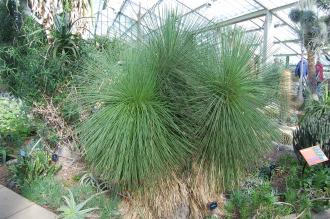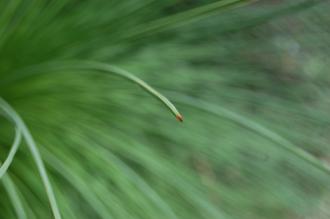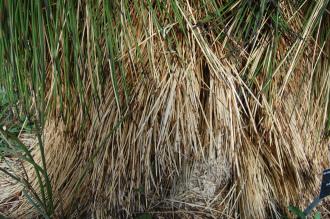
Yucca queretaroensis (28/02/2016, Kew Gardens, London)
Position: Full sun
Flowering period: Late summer
Soil: Dry, well drained
Eventual Height: 5m
Eventual Spread: 1.2m
Hardiness: 9a, 9b, 10a, 10b, 11
Family: Asparagaceae
Sub Family: Agavoideae
Yucca queretaroensis is a slow growing evergreen shrub with an upright habit. Its grey/ blue leaves are square in cross section, lanceolate with entire margins, up to 60cm long, 3mm broad and appear as a symmetrical rosette. Its dead leaves remain on the trunk, are pendulous and produce a skirt like appearance. Its white flowers are bell shaped and appear as erect flowering stalks as panicles which are up to 80cm long and emerge from its leaves.

Yucca queretaroensis Leaf (28/02/2016, Kew Gardens, London)
Yucca queretaroensis, commonly known as Queretaro Yucca, is native to Central Mexico. In it native habitat this plant grows in hills and canyons in places with low vegetation cover.
The etymological root of the binomial name Yucca is derived from the Carib (indigenous people of the Caribbean) name for cassava (misapplied to this plant). Queretaroensis is named after the Mexico state of Queretaro.
The landscape architect may find Yucca queretaroensis useful as an architectural specimen shrub suitable for xeriscaping planting schemes. Once established this plant is drought tollerant. This plant may be suitable as a house plant providing adequate light is provided.

Yucca queretaroensis Base (28/02/2016, Kew Gardens, London)
Ecologically, Yucca queretaroensis flowers are attractive to pollinating insects.
Yucca queretaroensis prefers dry, fertile,very well-drained soils. It prefers an alkali pH of soil. It will not tolerate wet soils.
Yucca queretaroensis requires little maintenance. Dead leaves may be removed from the trunk to promote a tidy appearance.

Landscape Architecture

